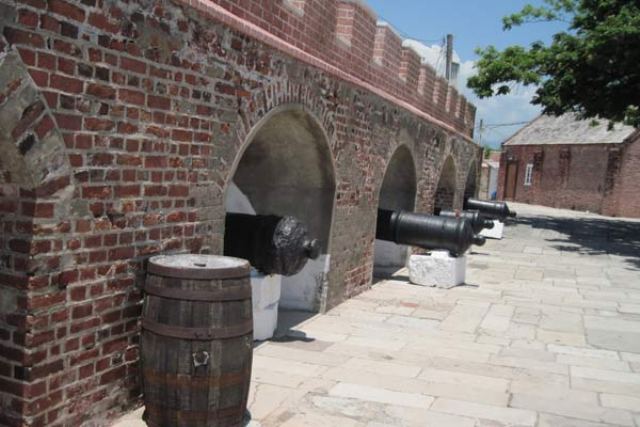 Port Royal in Jamaica was once the largest city in the Caribbean, operating as the centre of shipping and trade in the Caribbean Sea in the latter half of the 17th century. [Photo: The Fort Charles Museum, Port Royal]
Port Royal in Jamaica was once the largest city in the Caribbean, operating as the centre of shipping and trade in the Caribbean Sea in the latter half of the 17th century. [Photo: The Fort Charles Museum, Port Royal]
[This article appears in The Round Table: The Commonwealth Journal of International Affairs. Opinions expressed in articles do not reflect the position of the editorial board.]
The Government of Jamaica, like governments in other countries, has been promoting Heritage Tourism as many visitors desire more than the traditional ‘sun, sea and sand’. The Government says that this is in keeping with its policy of developing ‘the country’s heritage sites and marketing Jamaica’s rich cultural traditions’. These sites include buildings which are reported to have significant architectural value and in promoting them, emphasis is placed on their age, former use and attractiveness.
As an example, the Jamaica Product Development Company (a government entity) says that the ‘rich and unique heritage’ of the town of Falmouth in Trelawny is ‘characterized by its Georgian style architecture that has been around since the 1700s as well as its Sugar Rum and Emancipator William Knibb … This busy coastal town is perfect for walking tours, as visitors are able to learn about the town’s history and heritage through its many relics’.
Conveniently overlooked in this and in other promotional materials is that the British colonists primarily founded the town to facilitate the sugar industry that was based on the labour of enslaved Africans. The construction of Falmouth’s ‘Georgian style architecture’ was therefore made possible by the wealth generated by the sugar industry and the transatlantic slave trade, of which Falmouth was a centre.
Historic sites are also romanticised by private companies as can be seen from the following description of the Rose Hall Great House & Garden Tour: ‘Immerse yourself in the heritage of the island as your expert guide shares the story of this colonial ruin restored to its former majesty in the 1960’s. Learn about the lifestyle of the European bourgeoisie in the isles of the Caribbean in the Eighteenth Century. The tale of the Annee Palmer, the famed White Witch of Rose Hall is sure to delight. Beautiful tropical gardens and personalities will colour your experience with fun along the way!’
No mention is made that Rose Hall was a slave plantation as the emphasis is on the ‘lifestyle of the bourgeoisie’ and the lurid fictionised antics of the heroine.
With specific reference to the Caribbean, Copeland Stupart, in his 2012 doctoral thesis, argues that a major weakness in the region’s tourism product is the lack of cultural heritage sites which ‘make use of the “dark” cultural heritage of the region which is associated with the Transatlantic Trade in Africans as slaves’. He goes on to say that officials might be reluctant to promote sites dealing with slavery for fear that ‘the “unadulterated” display of the inhumane activities under slavery would evoke guilt in the descendants of the perpetrators which, in turn, would not be good for tourism’. In this statement lies the dilemma faced by the Government’s heritage tourism programme. A challenge is that the word ‘heritage’ has tended to be used to refer to the built environment – historic buildings, monuments and sites – hence the focus on great houses, churches and public buildings. However, these imposing edifices are part of the country’s colonial heritage and represent former imperial opulence, power and above all, control.
The recent global upsurge in black consciousness and the drive to remove, from public spaces, statues and other symbols connected to racial oppression, has resulted in a new awareness of the atrocities of the past and a need to acknowledge and come to terms with them. This means that the Government might be forced to examine how the country’s heritage is being represented. How, in other words, will they balance the new consciousness and sensitivity generated by the ‘Black Lives Matter Movement’ with the desire to promote aspects of our heritage to the mainly white tourists?
This can only be achieved if there is a more realistic approach to heritage tourism which takes into account full recognition of the African past and the role of the enslaved population in the construction of the very architectural structures being promoted. However, a critical approach by the Government requires a new mindset as to what constitutes our heritage and a willingness to deal openly with the institution of slavery. The development of an interactive museum on slavery might be one initiative which could be pursued. There is perhaps no more appropriate location for this than Falmouth, the capital of the parish which played a central role in the slave trade and the place where some of the largest fortunes were made as a result of the labours of the enslaved population.
John A. Aarons is a retired archivist from the University of the West Indies.



